GEEKOM A5 mini-PC Review: Affordable Cezanne Zen 3 at 35W
by Ganesh T S on December 8, 2023 9:15 AM ESTWorkstation Performance - SPECworkstation 3.1
SFF PCs traditionally do not lend themselves to workstation duties. However, a recent trend towards miniaturized workstations has been observed. While systems in the GEEKOM A5's form-factor are still not capable enough to become workstations, the rapid performance improvements over the years has encouraged us to benchmark some of these UCFF / SFF systems for content creation workloads and professional applications. Towards this, we processed the SPECworkstation 3.1 benchmark from SPEC.
The SPECworkstation 3.1 benchmark measures workstation performance based on a number of professional applications. It includes more than 140 tests based on 30 different workloads that exercise the CPU, graphics, I/O and memory hierarchy. These workloads fall into different categories.
- Media and Entertainment (3D animation, rendering)
- Product Development (CAD/CAM/CAE)
- Life Sciences (medical, molecular)
- Financial Services
- Energy (oil and gas)
- General Operations
- GPU Compute
Individual scores are generated for each test and a composite score for each category is calculated based on a reference machine (HP Z240 tower workstation using an Intel E3-1240 v5 CPU, an AMD Radeon Pro WX3100 GPU, 16GB of DDR4-2133, and a SanDisk 512GB SSD). Official benchmark results generated automatically by the benchmark itself are linked in the table below for the systems being compared.
| SPECworkstation 3.1 Official Results (2K) | |
| GEEKOM A5 | Run Summary |
| ASRock 4X4 BOX-5800U (Performance) | Run Summary |
| Intel NUC11PAQi7 (Panther Canyon) | Run Summary |
| ASRock NUC BOX-1360P-D5 (Performance) | Run Summary |
| ASRock 4X4 BOX-7735U (Performance) | Run Summary |
| ASUS PN50 | Run Summary |
| Intel NUC13ANKi7 (Arena Canyon) | Run Summary |
| ASRock NUCS BOX-1360P-D4 | Run Summary |
| ASRock NUC BOX-N97 | Run Summary |
| ASRock 4X4 BOX-4800U | Run Summary |
| ASUS PN51-E1 | Run Summary |
| Intel NUC12WSKi7 (Wall Street Canyon) | Run Summary |
| GEEKOM AS 6 (ASUS PN53) | Run Summary |
Details of the tests in each category, as well as an overall comparison of the systems on a per-category basis are presented below.
Media and Entertainment
The Media and Entertainment category comprises of workloads from five distinct applications:
- The Blender workload measures system performance for content creation using the open-source Blender application. Tests include rendering of scenes of varying complexity using the OpenGL and ray-tracing renderers.
- The Handbrake workload uses the open-source Handbrake application to transcode a 4K H.264 file into a H.265 file at 4K and 2K resolutions using the CPU capabilities alone.
- The LuxRender workload benchmarks the LuxCore physically based renderer using LuxMark.
- The Maya workload uses the SPECviewperf 13 maya-05 viewset to replay traces generated using the Autodesk Maya 2017 application for 3D animation.
- The 3ds Max workload uses the SPECviewperf 13 3dsmax-06 viewset to replay traces generated by Autodesk's 3ds Max 2016 using the default Nitrous DX11 driver. The workload represents system usage for 3D modeling tasks.
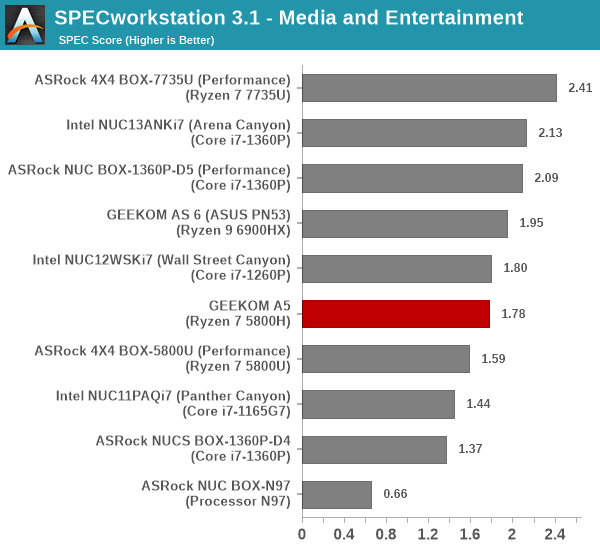
Product Development
The Product Development category comprises of eight distinct workloads:
- The Rodinia (CFD) workload benchmarks a computational fluid dynamics (CFD) algorithm.
- The WPCcfd workload benchmarks another CFD algorithm involving combustion and turbulence modeling.
- The CalculiX workload uses the Calculix finite-element analysis program to model a jet engine turbine's internal temperature.
- The Catia workload uses the catia-05 viewset from SPECviewperf 13 to replay traces generated by Dassault Systemes' CATIA V6 R2012 3D CAD application.
- The Creo workload uses the creo-02 viewset from SPECviewperf 13 to replay traces generated by PTC's Creo, a 3D CAD application.
- The NX workload uses the snx-03 viewset from SPECviewperf 13 to replay traces generated by the Siemens PLM NX 8.0 CAD/CAM/CAE application.
- The Solidworks workload uses the sw-04 viewset from SPECviewperf 13 to replay traces generated by Dassault Systemes' SolidWorks 2013 SP1 CAD/CAE application.
- The Showcase workload uses the showcase-02 viewset from SPECviewperf 13 to replay traces from Autodesk's Showcase 2013 3D visualization and presentation application
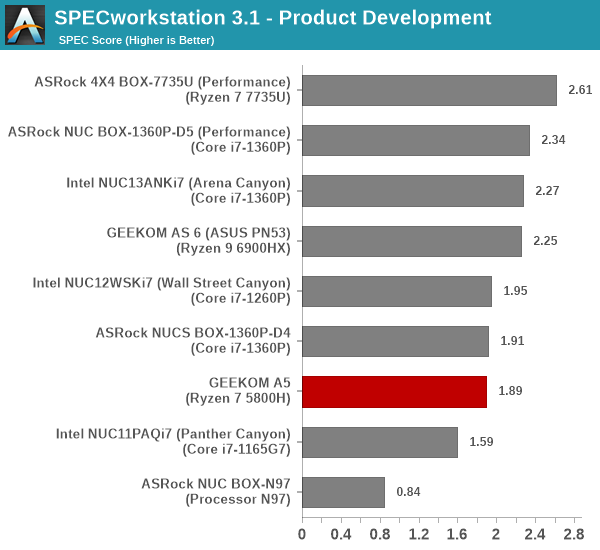
Life Sciences
The Life Sciences category comprises of four distinct test sets:
- The LAMMPS set comprises of five tests simulating different molecular properties using the LAMMPS molecular dynamics simulator.
- The NAMD set comprises of three tests simulating different molecular interactions.
- The Rodinia (Life Sciences) set comprises of four tests - the Heartwall medical imaging algorithm, the Lavamd algorithm for calculation of particle potential and relocation in a 3D space due to mutual forces, the Hotspot algorithm to estimate processor temperature with thermal simulations, and the SRAD anisotropic diffusion algorithm for denoising.
- The Medical workload uses the medical-02 viewset from SPECviewperf 13 to determine system performance for the Tuvok rendering core in the ImageVis3D volume visualization program.
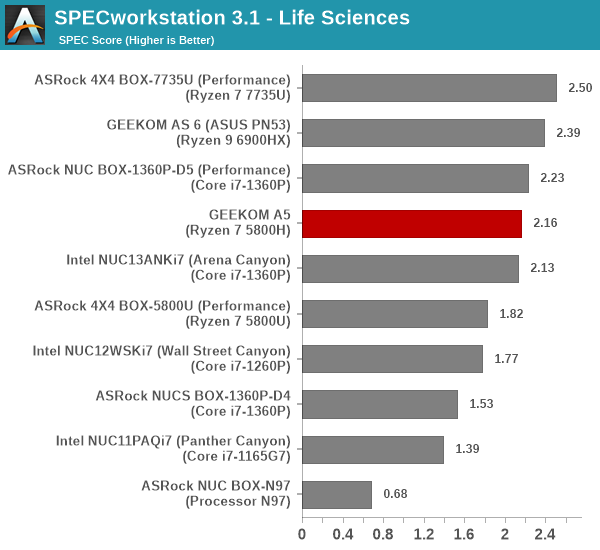
Financial Services
The Financial Services workload set benchmarks the system for three popular algorithms used in the financial services industry - the Monte Carlo probability simulation for risk assessment and forecast modeling, the Black-Scholes pricing model, and the Binomial Options pricing model.
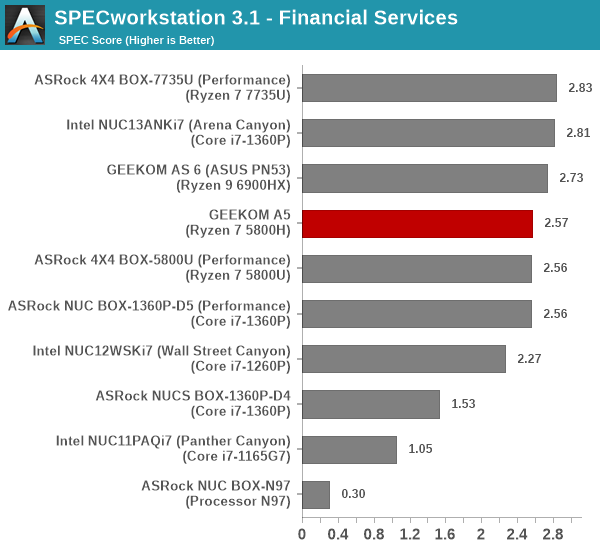
Energy
The Energy category comprises of workloads simulating various algorithms used in the oil and gas industry:
- The FFTW workload computes discrete Fourier transforms of large matrices.
- The Convolution workload computes the convolution of a random 100x100 filter on a 400 megapixel image.
- The SRMP workload processes the Surface-Related Multiples Prediction algorithm used in seismic data processing.
- The Kirchhoff Migration workload processes an algorithm to calculate the back propogation of a seismic wavefield.
- The Poisson workload takes advantage of the OpenMP multi-processing framework to solve the Poisson's equation.
- The Energy workload uses the energy-02 viewset from SPECviewperf 13 to determine system performance for the open-source OPendTec seismic visualization application.
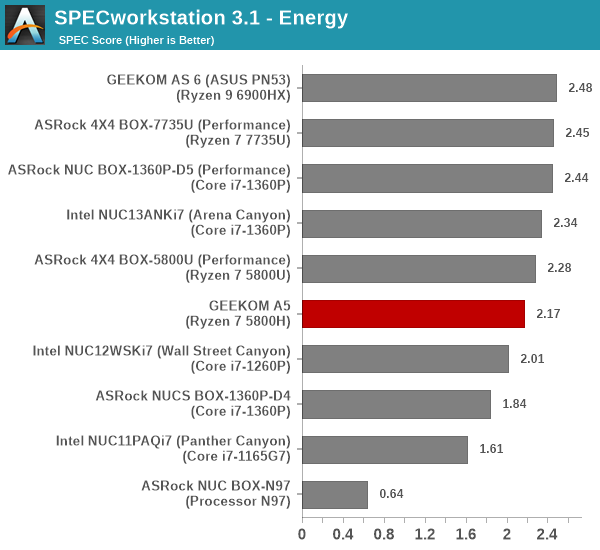
General Operations
In the General Options category, the focus is on workloads from widely used applications in the workstation market:
- The 7zip workload represents compression and decompression operations using the open-source 7zip file archiver program.
- The Python workload benchmarks math operations using the numpy and scipy libraries along with other Python features.
- The Octave workload performs math operations using the Octave programming language used in scientific computing.
- The Storage workload evaluates the performance of the underlying storage device using transaction traces from multiple workstation applications.
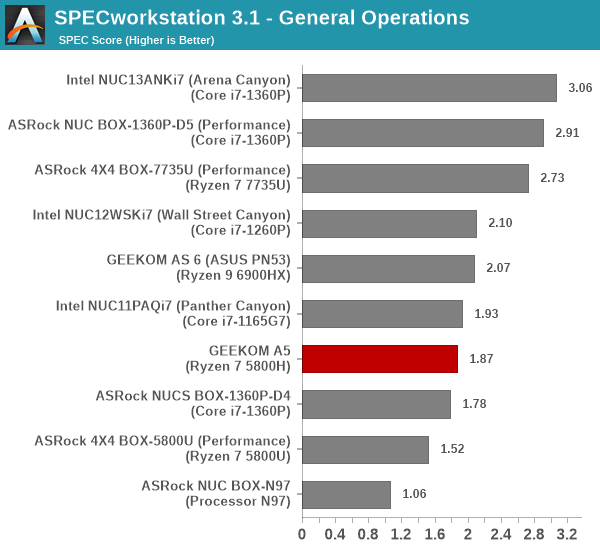
GPU Compute
In the GPU Compute category, the focus is on workloads taking advantage of the GPU compute capabilities using either OpenCL or CUDA, as applicable:
- The LuxRender benchmark is the same as the one seen in the media and entertainment category.
- The Caffe benchmark measures the performance of the Caffe deep-learning framework.
- The Folding@Home benchmark measures the performance of the system for distributed computing workloads focused on tasks such as protein folding and drug design.
We only process the OpenCL variants of the benchmark, as the CUDA version doesn't process correctly with default driver installs.
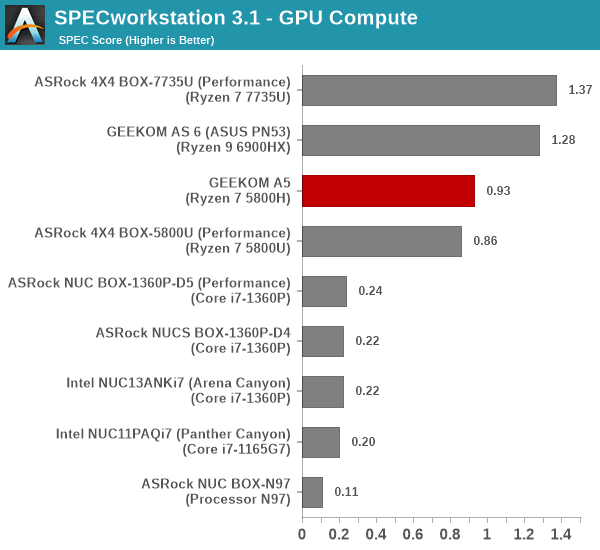
Workloads processed on workstations are long-running tasks that don't benefit in any meaningful way from short bursts of higher power. UCFF systems find it difficult to sustain these higher package power numbers for a long enough time to influence the performance in workstation benchmarks. As a result, the relative performance of the GEEKOM A5 in SPECviewperf v3.1 is dictated by its sustained package power limit of 35W. In all the workloads, the system tends to appear in the middle of the pack, closely tracking the other Cezanne-based system in the comparison list.










35 Comments
View All Comments
Reflex - Monday, December 11, 2023 - link
This is just a bizarre comment. These systems have a near top end CPU from the previous generation and can have up to 64GB of RAM. The vast majority of PC's sold are around 16GB of RAM and nobody complains about that (and this mini PC has twice that). Yes, web browsers can eat up a lot of memory, but regardless regular people and even many power users who aren't gamers are well served by these.As much as I love my overbuilt ITX system the fact is that I could get by on one of these things fine for everything but gaming, and I usually have 3 browsers open with dozens of tabs in each (guess what? Browsers hibernate tabs not in use), I do photo editing via Capture One and run a ton of messaging apps, some work applications and a desktop AI solution and my Ryzen 5700G handles it without breaking a sweat. I have 64GB of memory, which these mini PC's can handle as well, and my memory usage is rarely more than 35-50%.
I don't know what you believe a regular user does that requires so much more than what they offer but you may need a reality check.
ballsystemlord - Tuesday, December 12, 2023 - link
As I said to another reply, I mistakenly thought the mini-PC was equipped with 16GB of RAM.t.s - Friday, December 15, 2023 - link
still, 16GB of RAM is enough for running 20 tabs or more. Well, except, like they said, you watch dual 8k vr. BTW, I'm now with 32 firefox tab, 11GB RAM usage.StevoLincolnite - Wednesday, December 13, 2023 - link
Depends on the browser and what is going on.Some browsers are known to aggressively cache data into RAM.
However 8GB of Ram+Windows+Firefox I can happily run a dozen or more tabs with a decent SSD with music streaming in the background.
garblah - Friday, December 8, 2023 - link
No AV1 decoding in hardware. Small chance it could be an issue in a few of years, though the rise of AV1 to prominence has been slow.Not sure this configuration could brute force 4K AV1 playback without dropping frames. At any rate, I don't think the highest quality streaming content will be found as AV1 for another 4 years at minimum.
garblah - Friday, December 8, 2023 - link
*I see 8K 60p AV1 was tested for CPU usage. Why 8K 60p only... hmm.Samus - Saturday, December 9, 2023 - link
Is this OS license actually legit?meacupla - Sunday, December 10, 2023 - link
Win11 pro keys cost $36 for the end user. They probably cost like $10 for geekom, who get volume discountsSamus - Wednesday, December 13, 2023 - link
Sure, except this is equipped with Windows Enterprise...that's normally reserved for corporate and site-licensing, not end-user\resale applications.Very strange.
gz-0 - Saturday, December 9, 2023 - link
The comparison with different setups shows this to be the best for value. I was surprised that Intel setups seemed so inferior to the AMD setups.Looked closely at the lower cost, lower performances of the other AMD units. This seems to be the best. My previous experiences were with a Celeron 8GB memory unit. The lack of hardware ports was treated with external plugin ports.